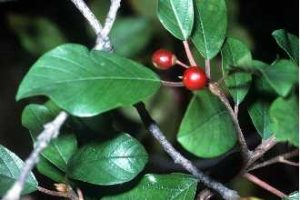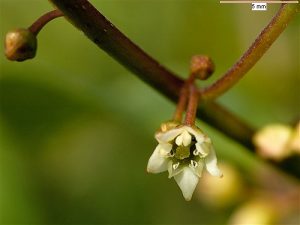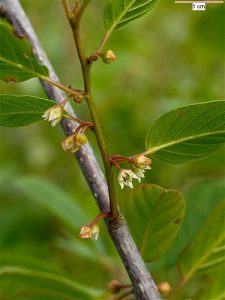Buckthorn
(Rhamnus frangula)
- Alias names for Buckthorn: Family Rhamnaceae, Common Buckthorn, Alder Buckthorn, Glossy Buckthorn, Frangula alnus, Chinese name: Rhamnus utilis Decne
About Buckthorn: Buckthorn, also called Alder Buckthorn is a deciduous shrub or small tree growing to 15 ft (5 m). Has smooth brown bark, oval to elliptical leaves, white flowers, and small round berries ripening from yellow to black. Alder buckthorn grows in the northeastern parts of the US and in Europe (except for the Mediterranean region and the extreme north). It prefers marshy woodland. The bark of trees at least 3 – 4 years old is collected in late spring and early summer, and is dried and stored for at least 1 year before use. Historically Buckthorn’s bark and fruits yield a yellow dye, once used to color paper and maps….mixed with gum Arabic and limewater to make a green pigment used in watercolor painting. Common buckthorn, a European native, is today used in veterinary medicine.
Actions and Uses of Buckthorn:
- Cathartic
- Emetic (anthrones and anthranols)
- Laxative (most common use) Its anthraquinones act on the wall of the colon, stimulating a bowel movement approximately 8-12 hours after ingestion.
Historical Uses of Buckthorn and How it Works: Once dried and stored, it is significantly milder than senna or common buckthorn, (R. catharticus); may be safely used over the long term to treat:
- Abdominal bloating
- Atonic constipation
- Beneficial remedy if the muscles of the colon are weak
- Cirrhosis
- Encourages the return of regular bowel movements
- Gallstones
- Gum disease (external application)
- Hepatitis
- Intestinal parasites
- Jaundice
- Liver and gall bladder complaints
- Poor bile flow
- Scalp infestations (external application)
- Skin diseases
Parts of Buckthorn Plant Used: Bark (dried and shredded or powdered) and fruit.
Properties of Buckthorn:
- Antiseptic
- Astringent
- Bitter
- Cleanses toxins from tissues
- Cooling herb
- Diuretic effects
- Purgative
- Stimulates the liver and gall bladder
Chemical Constituents of Buckthorn: Alder buckthorn contains 3 – 7% anthraquinones (including frangulin and emodin), anthrones, anthranols, an alkaloid (armepavine), tannins, and flavonoids.
Contraindications, safety issues, concerns, harmful drug interactions and allergy precautions for Buckthorn: Buckthorn should not be used to treat constipation resulting from excessive tension (bloating, impaction, torsion, blockage and that kind of thing) in the colon wall. Alder Buckthorn bark is toxic and violently purgative when fresh, but is safe once dried and stored for a year. The berries may also be harmful if eaten.
Note: Several Native American buckthorns that occur in the eastern U.S. that could be confused with the exotic species. If in doubt, consult with a knowledgeable botanist to get an accurate identification. Carolina buckthorn (Rhamnus caroliniana), is a lovely native shrub that has finely toothed leaves somewhat resembling those of black cherry, and are smooth on the underside; it produces attractive fruits from August to October. Alder buckthorn (Rhamnus alnifolia), is a low-growing shrub that may grow to a maximum of 3 feet in height, and has leaves with 6-7 pairs of veins.
Propagation Tips for Buckthorn: The Buckthorn plant is an overwintering host for the soybean aphid so is considered a noxious weed back East. It is not used very often these days. In some states it’s on the Most Unwanted List!
Pictures of Buckthorn:
Helpful Links and References for Buckthorn:
These products are not drugs, but foods for special dietary use pursuant to applicable Federal law. No statement in this page shall be construed as offering these products for the diagnosis, cure, mitigation, treatment, or prevention of any disease.
Related Pages:


